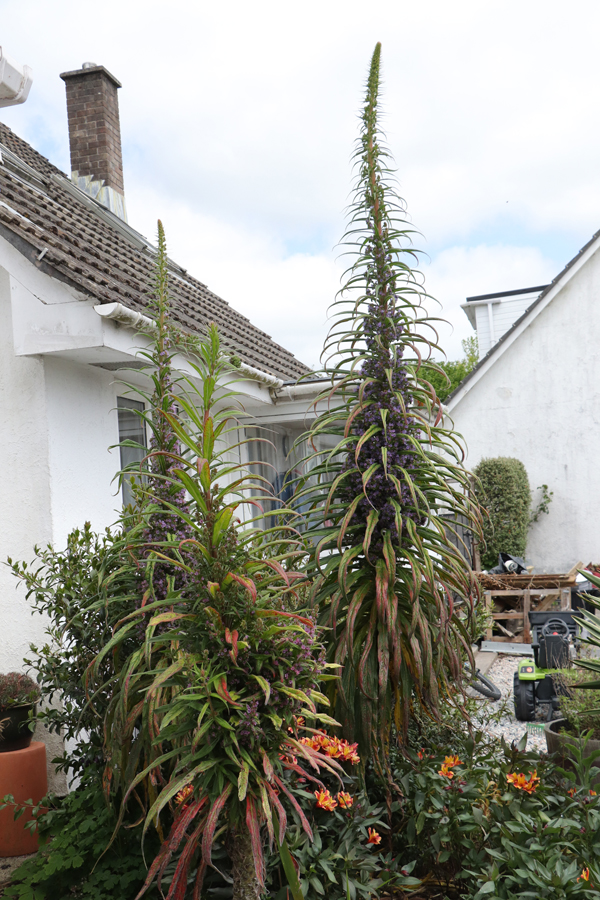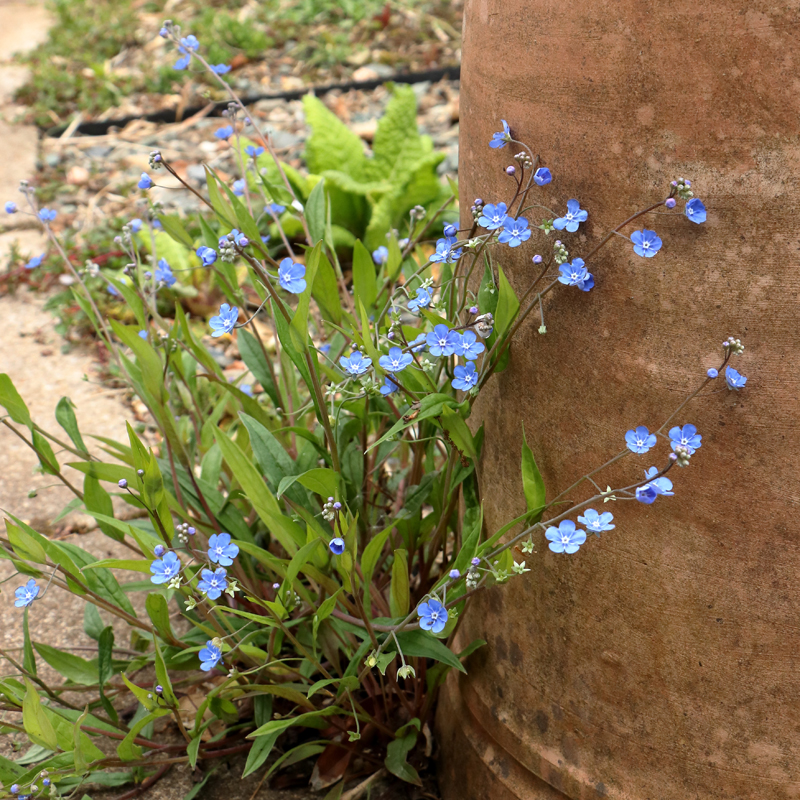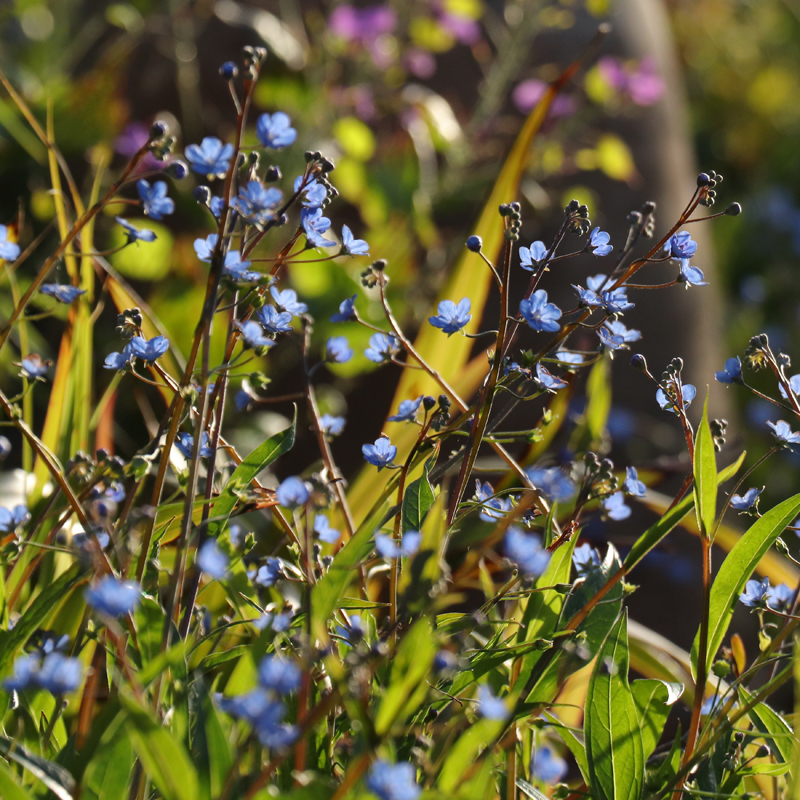May is the month where it can all run away from you if you take your eye off the ball for a second. So much happening, so much needing doing. A lot of what needs doing is weeding and watering, which eats into the time you need for planting and preening. Quite a bit of planting and preening has been done and more is scheduled in coming days. Next week may feature newly planted stuff, this week is all about established plants.
One.
Euphorbia pruning. The Euphorbia in question being E. mellifera, which had completely blocked paths on two sides and was smothering an Azalea on another. The flowers were starting to develop into seeds, I need it to have recovered some for when we have the garden open; time to stop putting it off.


Usually there is a reasonable growth of young shoots under the main canopy that I leave until new shoots are well under way from the cut stumps. Not this time, as you can see, just a meagre few spindly shoots that I decided I’d be better off without. The honesty around the Azalea has all but finished flowering and there’s loads more on the other side of the path.
Two.
Meanwhile, in the front garden, the Echiums are getting steadily bigger and are flowering prodigiously. I’ve seen much bigger ones but I’m happy with what I’ve got. The biggest one is around 9½ feet tall and I think it has a bit more to give yet.
Three.
I was going to crop the picture to show this fern to best effect but I don’t think it needs any help from me. There are six other ferns in the picture, all of them good, and still Athyrium otophorum okanum steals the limelight.
Four.
It is the season for shade plants, getting their growing and flowering in early while there’s moisture in the ground and the tree canopy is still letting some light through. Maianthemum racemosum subsp. amplexicaule ‘Emily Moody’, to give her the full title, is as good as she’s ever been. At a little over 3 feet tall, she carries her strongly lily-of-the-valley scented flowers where you don’t need to be on your knees to smell them. Very little troubled by slugs, much less troubled by sawfly than Solomon’s seal, robustly perennial. How am I doing? You’d think I had plants to sell, but I don’t. I have been seeing sawfly adults, black flies, not very nimble, looking to mate and lay eggs. It isn’t going well for them.
Five.
Omphalodes nitida is a plant that I’m happy to have seeding about in moderation. It’s another of the forget-me-not tribe, flowering relatively sparsely but over several months. I saw this one flowering against the contrasting background of a rhubarb forcer and thought it had at long last earned a Saturday outing. The other end of the day saw it catching a few late rays, sending me scurrying for the camera once more.
Six.
Number six, the last slot. Melaleuca squarrosa, Polygonatum hybridum ‘Striatum’, my unknown but beautifully scented Azalea species, a couple more unfurling ferns; all failed to make the cut. I have a first flower on Cypripedium ‘Gisela’, a plant whose very survival seems like an epic achievement. There is a world of even more lovely supposedly garden tough Cypripediums out there but I saw this one going relatively inexpensively so it seemed a good one to plant as a try out. It’s going to need to do better than this to persuade me to buy a load more but it’s a start.
I’m almost on top of the weeds on my allotment, hopefully this weekend should see that battle concluded. In the garden the bluebells are mostly finished so I will be tidying them up and getting some planting out done. The worst and best of gardening in two lines really. I’m keen to see what everyone else has to show off here, starting with The Propagator, will there still be tulips?










That’s a lovely Cypripedium. It looks so much like my tiny pink lady’s slipper.
LikeLike
I don’t know the parentage of Gisela, we only have one native Cypripedium and that vanishingly rare. I hope I can keep it going.
LikeLike
How times have changed. Once all gardening writing referred to the “May gap” whereas nowadays there is quite the opposite, a May flush of growth.
LikeLike
Very hard to see it as an unalloyed positive, as grudging as it sounds to say so.
LikeLiked by 1 person
I was giving the mellifera a threatening look yesterday, checking it over to see where I would be cutting it back to. It’s not going to seed yet so perhaps in another week. i have my eye on some omphalodes, always on the hunt for shade lovers and gentle self seeders.
LikeLiked by 1 person
Oh wow to the echiums! Show-stoppers! And, do you know what varieties of cosmos you have growing there in your header photo? I like the lighter pink ones.
LikeLike
They’re Argyranthemums and I’m pretty sure they didn’t have labels on them; I’ll have a look tomorrow. There was a big block of them at the garden centre and just did the pick and mix thing like kids in a sweet shop. I’m already wishing we’d bought more.
LikeLike
The echium is tremendous. I planted one that I am hoping will survive long enough to send up such a dazzling spire. The color combination of the forget-me-not and the rhubarb forcer is lovely.
LikeLike
I was at a nursery today which had three or four other Echium species, so tempting but I think the one I have is the hardiest and it only just survives. I resisted successfully.
LikeLike
Wow! You weren’t joking about pruning that Euphorbia! Can I be so bold with Euphorbia Martini I wonder? Though I really need to move it completely as it is in my herb garden.
LikeLike
Euphorbias don’t like being moved; does your martinii produce shoots at the base? I suspect it might if it’s young and vigorous but not if its a few years old.
LikeLiked by 1 person
Mmm… I need to look.
LikeLiked by 1 person
Amazing Echiums! Yes, everything is shooting up this month. The “forget-me-nots” are a very pretty colour, stronger blue than the actual ones
LikeLike
The blue flowers are well spaced out on very fine dark stems, it’s a pleasing effect.
LikeLike
What a special blog this week with such interesting things and a great help to show us the marauding Sawfly. They always get my Solomon’s Seal and there are so many flying bugs out extra early this year after the mild winter, so I am sure they are poised here too..
LikeLike
Getting the adults seems to be a pretty effective strategy with the sawfly early on, though I still get plenty of caterpillars later.
LikeLike
You have a lovely garden, Jim. Glad I dropped in!
LikeLike
Thank you, call again, it doesn’t stay the same for long.
LikeLiked by 1 person
That’s what I love about nature, she is always working…
LikeLiked by 1 person
You are quite right, May is a crazy, going up the down escalator sort of month. Still it is all fun right? Your garden is looking amazing in its craziness!
LikeLiked by 1 person
Crazy seems to suit me. Bought a couple of small Caladiums today and am wondering if they’d be happy in the garden for summer; in short, I’m getting crazier.
LikeLike
Oh, I remember that Maianthemum racemosum subsp. ‘Emily Moody’. It is what gave me an appreciation for the native version of it here
LikeLiked by 1 person
It’s a very fine plant and I’m feeling pleased with myself for raising half a dozen seedlings, though they are painfully slow. Hopefully I’ll live to see them flower!
LikeLiked by 1 person
The specimen that I ignored within one of our landscapes has spread nicely in only a few years. It is certainly not aggressive about it, but has become quite an asset to the unrefined landscape. It would be nice to be able to dig and relocate some of it. I tried while it was still confined to a small area, but could not find it after the foliage died off. I should be more diligent about marking it.
LikeLike
Does it appear to spread only vegetatively in the wild or are there seedling plants around as well?
LikeLiked by 1 person
I have no idea how it gets around. I have never seen a seedling, but the plant that is now developing into a small colony at work got there somehow since the late 1980s (when the region was graded for the adjacent building). It could have grown from a bit mixed into the excavated soil. I really do not know. Those that I see on the farm were there prior to my arrival, and generally do not change much. Some grow into small colonies, but might eventually diminish back to just a few shoots for a while.
LikeLike
There are certain species here that are regarded as indicators of ancient woodland, which could be either because they spread very slowly through an area or on average take a very long time to arrive in a woodland, perhaps both. Ancient woodland scores very highly in conservation priorities. Some species obviously spread rapidly by seed, others spread rapidly vegetatively, then there are things that I wouldn’t have a clue about. Is seed production more about dispersal, perhaps with birds involved? What are the evolutionary implications for species that rarely if ever grow from seed and does it mean they’re less adaptable? So many questions.
LikeLiked by 1 person
We notice it all in the many different climates of California. Ecosystems of the redwood forests change so slowly that some of the slowly migrating native perennials that survived clear cut harvest a century ago continue to recover along with the regeneration of the forests. They never left. (Unfortunately, the fires are associated with that recovery.) In desert regions, seed of annual plants get dispersed so extensively and so efficiently each season that they can appear many miles from where they started, while original colonies temporarily disappear. Yet, some colonies of desert plants that migrate with tectonic activity, particularly perennials, are very ancient! I sort of wonder how some plants get around. I can understand how elderberries get around with birds, and eventually develop into distinct species on different continents; but then there are plants with big seeds that birds to not eat whole, such as soapberry, that somehow as native to Hawaii as it is native to Oklahoma! How did it get to Hawaii?!
LikeLike
I was having a conversation with an Irish lady about Arbutus unedo growing in Ireland, which she was inclined to ascribe to the ‘Celts’, who get blamed/credit for all sorts of things. It grows down through Spain and Portugal, in Morocco, the middle east and as far up as Ukraine. Sometimes the question is why doesn’t something grow somewhere.
LikeLiked by 1 person
I would guess that Arbutus unedo is easily dispersed by birds. The Celts would have dispersed it only if they thought it was useful for something, such as fruit production. Several environmental conditions limit its migration into areas where the Celts would not have brought it. I think of climate as the primary limiting factor of plant migration, although I am aware that the soils are very different in various regions of California, as well as Europe. Some plants that survive in the salt marshes around San Francisco Bay, or worse, in the saline regions of the Mojave Desert, can not survive in what seems to be more appealing soil, even within an ideal climate for them.
LikeLike
It’s immensely complicated and has played out over a time scale that means we know little or nothing about exactly what it was like a few hundreds or thousands of years ago that affected plant distribution now. Even a short run of wet/dry, cold/hot years would change the relationships and push the odd thing over the edge. It’s so tempting to try simplify what is almost incomprehensibly complex.
LikeLiked by 1 person
Great job pruning the euphorbia, it gives me an idea of what I will have to do in a few years when mine will be this big. Amazing echiums! .. and cypripediums are on my wish list too.
LikeLiked by 1 person
I have a nervous few weeks waiting for the Euphorbia to shoot; it always has, so far. Cypripediums were on my wish list for decades, taking the plaunge was long overdue.
LikeLike
Gosh a garden and an allotment, it must keep you very busy.
LikeLike
There’s nothing I’d rather be doing, busy but contented.
LikeLike
There are always some special and amazing plants in your garden Jim, but I can’t help but be drawn to more modest Omphalodes nitida , As you said against the forcer, beautifully poised.
LikeLike
It’s a good plant and modest is a good word for it.
LikeLike